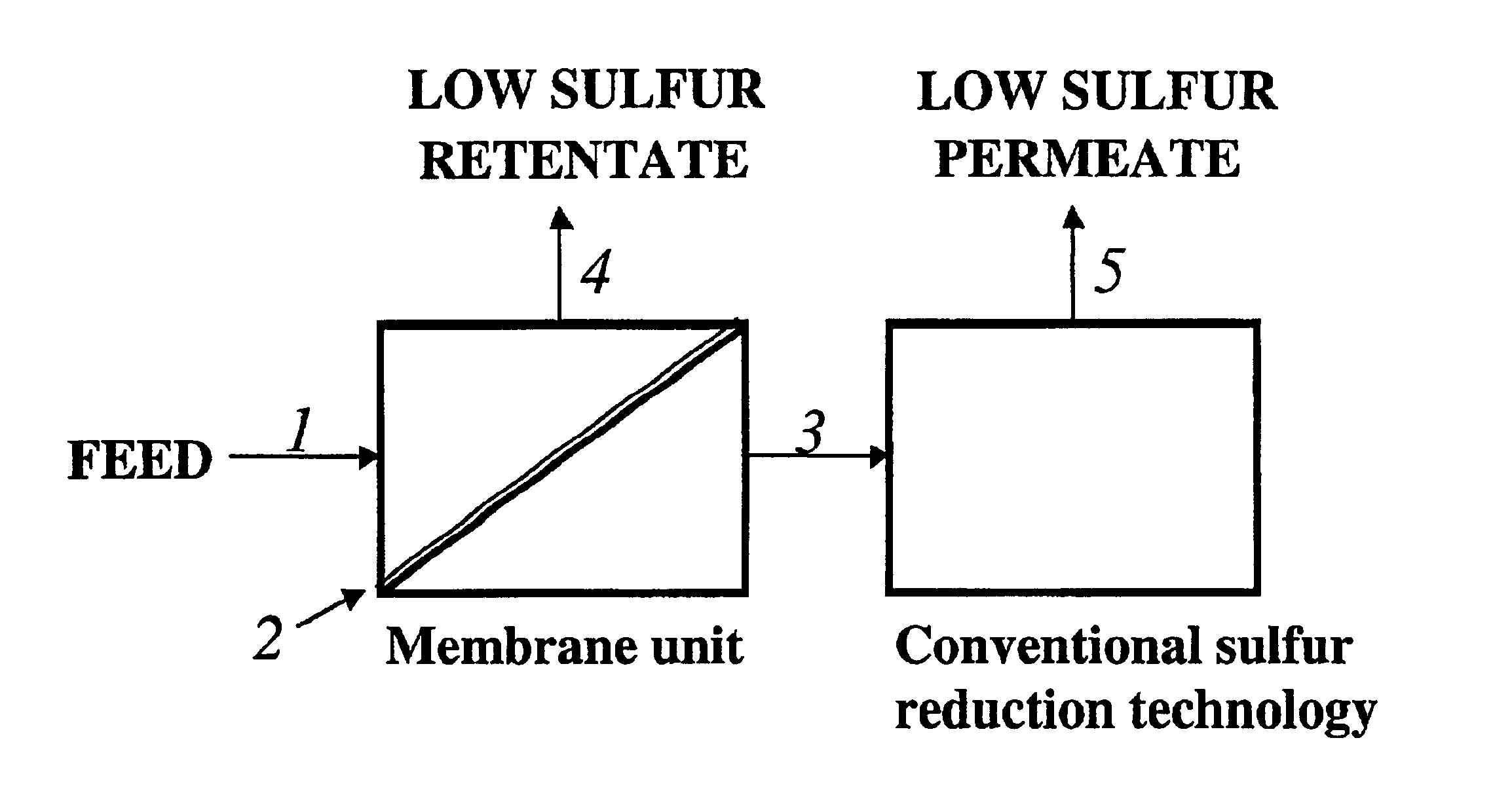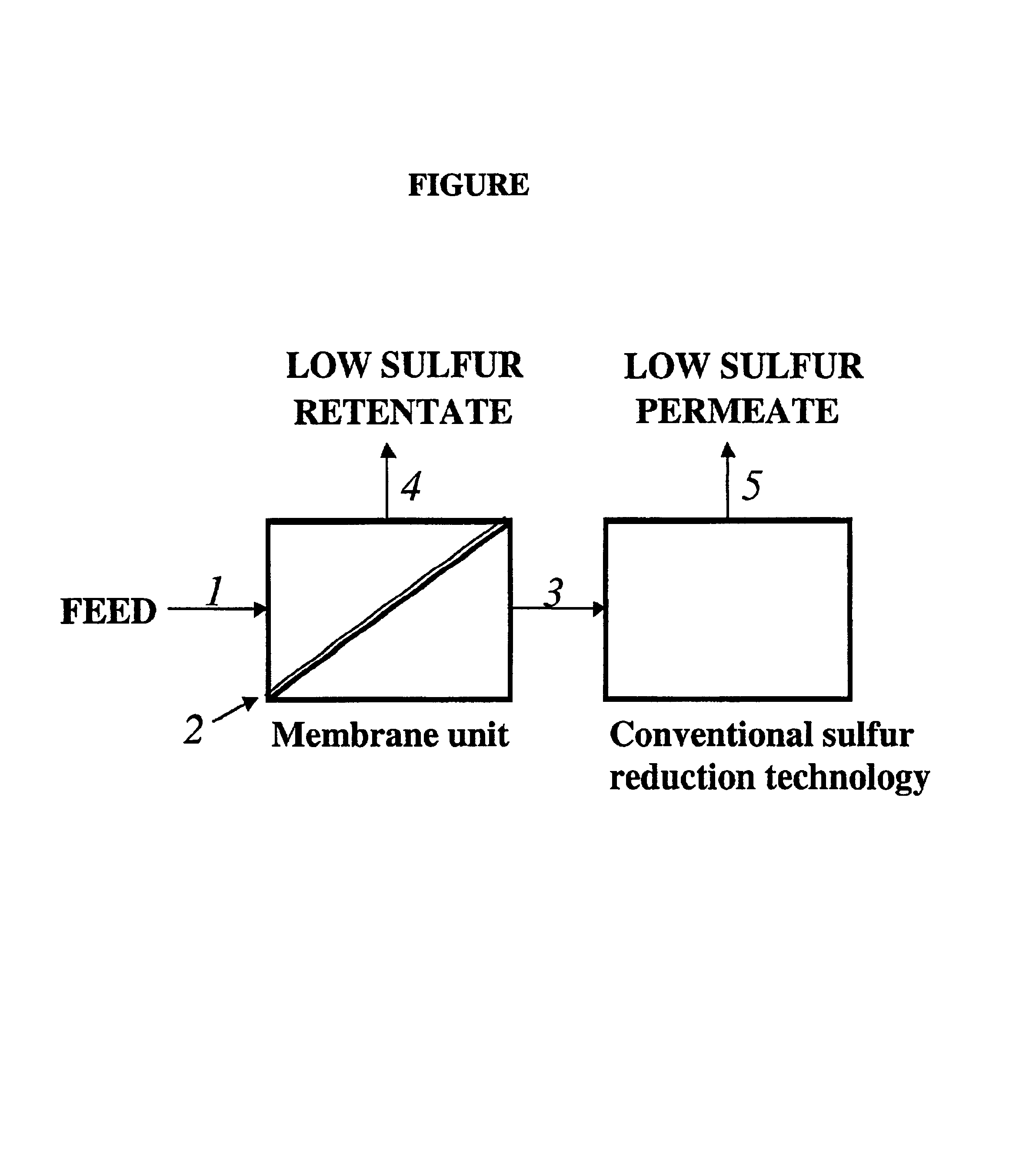Membrane separation for sulfur reduction
a technology of sulfur reduction and membrane separation, which is applied in the direction of hydrocarbon purification/separation, hydrocarbon oil refining, and filtration. it can solve the problems of increasing operating costs, reducing the efficiency of hydrotreating, and reducing the volume of feed, so as to reduce the cost of sulfur reduction, improve economics, and reduce the effect of feed volum
- Summary
- Abstract
- Description
- Claims
- Application Information
AI Technical Summary
Benefits of technology
Problems solved by technology
Method used
Image
Examples
example 1
[0047]A commercial pervaporation membrane (PERVAP® 1060) from Sulzer ChemTech, Switzerland, with a polysiloxane separation layer, was tested with a 5 component model feed (Table 1). The membrane shows a substantial permeation rate and an enrichment factor of 2.35 for thiophene. At the higher temperature with naphtha feedstock the mercaptans (alkyl S) had a 2.37 enrichment factor.
[0048]The same membrane was also tested with a refinery naphtha stream (Table 2). The compounds at the heavier end of this naphtha sample have higher boiling points than the operating temperature leading to lower permeation rates through the membrane for those components. Increase in temperature gives higher permeation rates.
[0049]The comparison of feed solutions between Tables 1 and 2 showed that solutions with both relatively high and low thiophene content can be enriched in the membrane permeate.
[0050]
TABLE 1Pervaporation experiments with model feedMembrane from Example 1FeedPermeatePermeateFeed temperatu...
example 2
[0052]A polyimide membrane was fashioned according to the methods of U.S. Pat. No. 5,264,166 and tested for pervaporation. A dope solution containing 26% Matrimid 5218 polyimide, 5% maleic acid, 20% acetone, and 49% N-methyl pyrrolidone was cast at 4 ft / min onto a non-woven polyester fabric with a blade gap set at 7 mil. After about 30 seconds the coated fabric was quenched in water at 22° C. to form the membrane structure. The membrane was washed with water to remove residual solvents, then solvent exchanged by immersion in 2-propanone, followed by immersion in a bath of equal mixtures of lube oil / 2-propanone / toluene bath. The membrane was air dried to yield an asymmetric membrane filled with a conditioning agent.
[0053]For pervaporation testing, the membrane was rinsed with the feed solution, and then mounted solvent wet in the cell holder. Results for a 5-component model feed are shown in Table 3. Curiously, the pervaporation performance improved at the higher temperature in both ...
example 3
[0055]Another polyimide membrane was fashioned according to the methods of U.S. patent application Ser. No. 09 / 126,261 and tested for pervaporation. A dope solution containing 20% Lenzing P84, 69% p-dioxane, and 11% dimethylformamide was cast at 4 ft / min onto a non-woven polyester fabric with a blade gap set at 7 mil. After about 3 seconds the coated fabric was quenched in water at 20° C. to form the membrane structure. The membrane was washed with water to remove residual solvents, solvent exchanged by immersion in 2-butanone, followed by immersion in a bath of equal mixtures lube oil / 2-butanone / toluene. The membrane was then air dried to yield an asymmetric membrane filled with a conditioning agent.
[0056]For pervaporation testing, the membrane was rinsed with the feed solution, and then mounted solvent wet in the cell holder. Results with naphtha are shown in Table 4. The membrane showed an enrichment factor of 4.69 for thiophene. Mercaptans (alkyl S) had a 3.45 enrichment factor....
PUM
| Property | Measurement | Unit |
|---|---|---|
| wt % | aaaaa | aaaaa |
| temperature | aaaaa | aaaaa |
| pressure | aaaaa | aaaaa |
Abstract
Description
Claims
Application Information
 Login to View More
Login to View More - R&D
- Intellectual Property
- Life Sciences
- Materials
- Tech Scout
- Unparalleled Data Quality
- Higher Quality Content
- 60% Fewer Hallucinations
Browse by: Latest US Patents, China's latest patents, Technical Efficacy Thesaurus, Application Domain, Technology Topic, Popular Technical Reports.
© 2025 PatSnap. All rights reserved.Legal|Privacy policy|Modern Slavery Act Transparency Statement|Sitemap|About US| Contact US: help@patsnap.com


